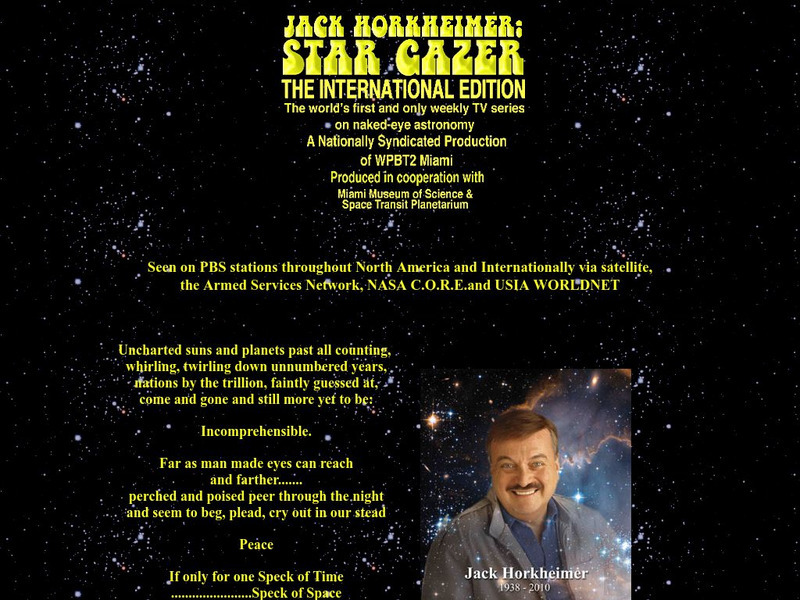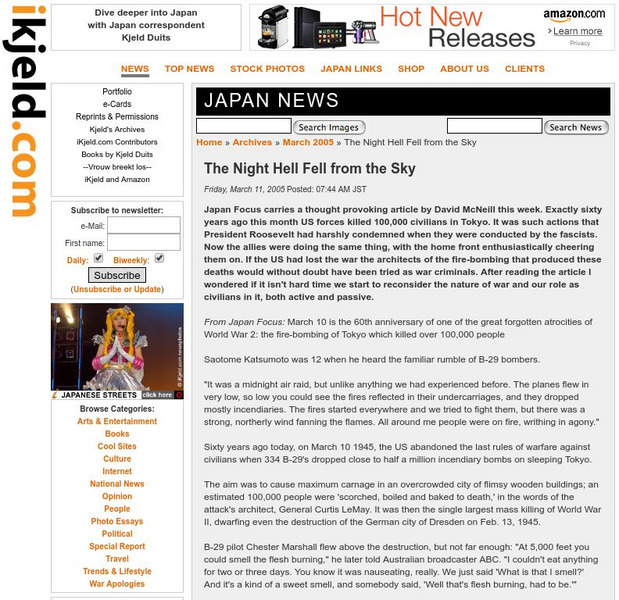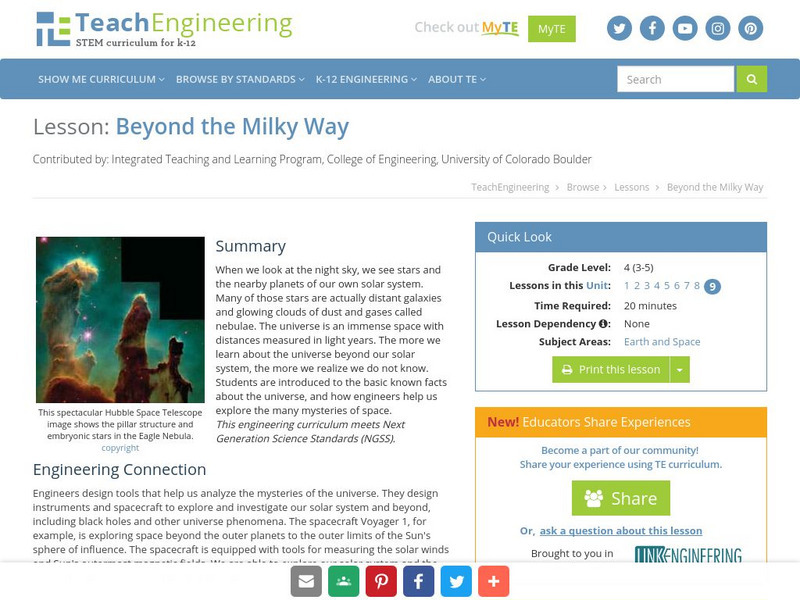Hi, what do you want to do?
Science Buddies
Science Buddies: Where Did All the Stars Go?
If you live in a big city or urban area it is hard to see many stars at night. In most urban areas only the most brilliant stars, planets and the moon can be seen. This is because of something called light pollution which is the...
BSCS Science Learning
Bscs: Globe at Night Dark Skies
In this inquiry, learners predict the best place to stargaze in Arizona based on the brightness of the night sky. Students are introduced to the concept of light pollution and Globe at Night, a global citizen science project in which...
BSCS Science Learning
Bscs: Globe at Night Dark Skies
In this inquiry, students predict the best place to stargaze in Arizona based on the brightness of the night sky. Students are introduced to the concept of light pollution and Globe at Night, a global citizen science project in which...
TED Talks
Ted: Ted Ed: The Origin of Countless Conspiracy Theories
Why can we find geometric shapes in the night sky? How can we know that at least two people in London have exactly the same number of hairs on their head? And why can patterns be found in just about any text - even Vanilla Ice lyrics?...
Sophia Learning
Sophia: Bill Nye: Once in a Mega Moon
Bill Nye explains why the moon appears smaller when it is higher in the sky, and he presents a Home Demo experiment that proves its an illusion. The experiment requires a bright moon on a clear night, a stiff piece of cardboard, and a...
NASA
Astronomical Society of the Pacific: Telescope Treasure Hunt
This hands-on astronomy activity lets learners hunt for different objects in the night sky that contribute to stellar and planetary formation, using a Treasure List. They will learn how stars and their planets form and will find objects...
Other
Sea and Sky: The Constellations
Is that a lion in the sky? Find out what the constellations are, how they were named, and when stargazers might see specific ones throughout the year.
Sophia Learning
Sophia: Phases of the Moon
This lesson will introduce the phases of the moon and why the moon appears to change shape in the night sky throughout the month.
American Association of Physics Teachers
Com Padre Digital Library: Open Source Physics: Equatorial Coordinates Model
Using equatorial coordinates, observers will examine the position of a star over the course of the night sky in this simulation.
Other
Jack Horkheimer: Star Gazer
This is a site on astronomy in general. If you are into astrophotography, you can find out what is happening in the heavens! Jack Horkheimer is also seen on PBS. You can access the 5 or 1 minute shows on this site.
PBS
Pbs Teachers: Shackleton's Antarctic Odyssey: Let the North Star Tell You Where
Through this lesson, students will understand how to determine latitude and locate specific stars in the night sky. They will also have a chance to build and use an astrolabe.
Environmental Education for Kids
Eek!: Be the Change: Light Pollution?
Light pollution is a particular concern in urban areas as people cannot enjoy looking at the night sky and all this light is being wasted.
PBS
Pbs: Rough Science Island Observatory
PBS site asks users to imagine that they are stranded on a tropical island. Provides experiments for users to calculate time at night and to identify what is in the night sky.
Other
Japan News: The Night Hell Fell From the Sky
A powerful article written for a Japanese publication about an event rarely touched in World War 2 history. That is the fire bombing of Tokyo, which killed over 100,000 on March 10th, 1945. Students of the Cold War might recognize some...
Other
University of Leicester: Comets, Asteroids & Meteorites
Provides a general overview of comets, asteroids, and meteorites. Content includes ways to identify them in the night sky, as well as detailed information on each type of small body.
Globio
Glossopedia: Stars
Many of the objects you can see in the night sky are stars, large objects in space that produce light. Our galaxy, the Milky Way, contains more than 100 billion stars. Stars are so far away that their light does not reach us for years....
Science Buddies
Science Buddies: Using a Digital Camera to Measure Skyglow
This is a great project for someone that is interested in both stargazing and photography. Bright city lights and even the light of the full moon obscure the dimmest stars, which can make identifying constellations more difficult. This...
Other
Sunaeon: Solar System Scope
Experience the solar system as you've never seen it before; up close and personal. Visit each planet by clicking on it, then selecting the play button to track its rotations through the calendar year. Watch the constellations move...
AdLit
Ad lit.org: Reading Discussion Guide: The Last of the Sky Pirates
Fifty years after Captain Twig severed the anchor chain securing the floating rock of Sanctaphrax to Undertown, all is not well in the great floating city or the urban sprawl of Undertown. Rook Barkwater is selected as a Librarian Knight...
TeachEngineering
Teach Engineering: Beyond the Milky Way
When we look at the night sky, we see stars and the nearby planets of our own solar system. Many of those stars are actually distant galaxies and glowing clouds of dust and gases called nebulae. The universe is an immense space with...
PBS
Star Map
This star map has five different constellations along with four newly discovered solar systems. If you are located in the northern hemisphere you can use this resource to locate stars.
Other
Bscs: Globe at Night Dark Skies
In this self-directed lesson, students investigate what contributes to light pollution using data from locations around the globe. A handout with everything the student needs to complete this lesson is available as a PDF or Google Document.
Read Works
Read Works: Stargazing
[Free Registration/Login Required] An informational text about stars in the night sky. A question sheet is available to help students build skills in reading comprehension.
Science Buddies
Science Buddies: Changing Constellations
Do you like to look up into the night sky? There are so many stars, it can be mind boggling. Some ancient people marked time by the changes in star patterns. We still use changes in constellation patterns to mark astronomical time. This...























